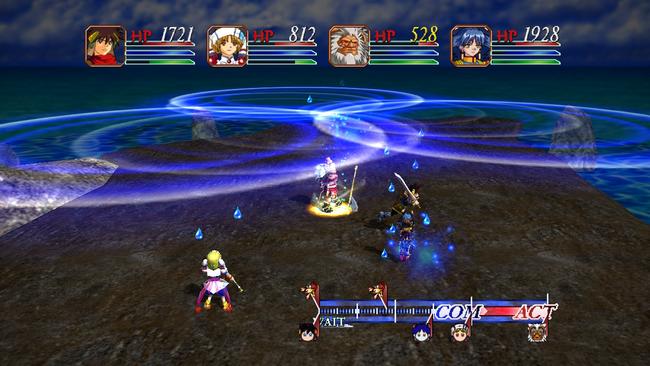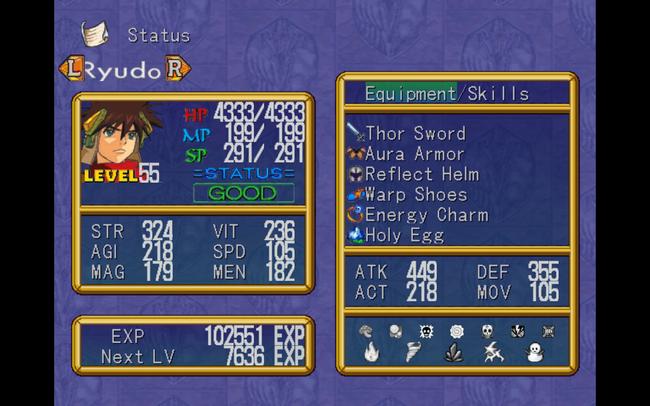Grandia II is 2000s pop perfection
This year marks the 23rd anniversary of Grandia II's release for the Sega Dreamcast. The short-lived console had a surprising number of RPGs; but for me, Grandia II was the big reason I needed a Dreamcast. It was the sequel to Grandia, a game I had only played the year before when it was ported over to the PlayStation for a Western release. Since then, Grandia II itself has been ported a few times - most recently to the Switch in a remaster featuring the first two games. Replaying it ahead of its anniversary helped me realize that Grandia II is a perfect slice of early 2000s RPGs.
Grandia II sees players controlling Ryudo, a mercenary known as a "Geohound." Ryudo is hired to accompany a gaggle of young women — including a songstress named Elena — on a mission trip for their deity, Lord Granas. When completing a ritual, the group is mysteriously slaughtered but for Elena.

It is quickly revealed her body possesses one of the pieces of Valmar, the dark god who opposes Granas. Elena happens to share her body with Milennia, a haughty demoness who is known as the "Wings of Valmar." While Milennia is initially hostile to the group as an unwilling participant, her attitude towards Ryudo and the rest of the party softens over time. From there, Ryudo and Elena go on a mission to collect the pieces of Valmar's body in an attempt to prevent his awakening.
The story is pure RPG, leaning into tropes so hard it practically falls over. While it may be basic, the solid characterization of these archetypes and story beats makes the characters engaging (and at times, amusing). We have a sarcastic mercenary with a heart of gold who unwittingly becomes a god-defying hero. It could just as easily have been the plot of an anime from 2000, but the characters are earnest enough to sell them as believable, despite a localization deeply rooted in the early 2000s. The script has at least several instances of slightly problematic language, which may bother.
Similar to the first Grandia, the spell names are obnoxiously cutesey, with spells like "Zap!" It is sometimes difficult to figure out what a spell does, with some debuff abilities given confusing names: the spell "Freeze!" reduces enemy movement while "Crackle" causes ice damage. The game has personality, if nothing else. This minor quibble aside, the story and localization does not take itself too seriously, and the game is more enjoyable as a result.

The script is supported by solid voice acting featuring some iconic actors - from before the days of highly public social media personas. Ryudo is voiced by Cam Clarke who is notable for, among many other roles, voicing Leonardo in the classic 1980's Teenage Mutant Ninja Turtles series. The cast also features the talents of Jodi Benson, the voice of Ariel in Disney's The Little Mermaid, as well as Jennifer Hale, who is one of the world's most prolific voice actors. Some performances might seem stiff by today's standards, but there's something about this voice cast that triggers those nostalgia receptors, as if I am watching Saturday morning cartoons. There has to be an anime adaptation of this somewhere, right?
The graphics are one of the areas where Grandia II reveals its age. The character models, especially outside of combat, are a bit ugly. A mix of chibi and more sophisticated body models topped off with round faces completely barren except for two eyes, even for the main characters. It reads as chunky and blocky and has not aged as well as the graphics of the consoles that came before and after. It lacks the timeless 2D sprite styles of the 16-bit era and is a generation or two away from the ornate designs or photorealism gamers have come to expect. They remind me of graphics from a few other games of this era, like Evolution for Dreamcast. In a way, Grandia II reminds me of Wild Arms - kinda ugly in retrospect, but damn if I wasn't smitten 20 years ago. Even the menus and fonts feel vintage in a way that is hard to appreciate unless you remember when it was new.

The game's combat is frantic and fun, relying on a movement gauge rather than pure turn-based mechanics to allow players to time their attacks. Players can see each party member and enemy on a line, each moving according to their movement/action speed. After selecting an attack or ability, the action is eventually executed when each player icon reaches the end of the action gauge (you have to factor in model positioning on the battlefield as well). Characters can do a basic or critical attack or rely on skills or spells in combat. The strength of the spell or ability directly impacts the charging time, during which enemies can attack and interrupt or even cancel the move.In fact, Grandia’s timeline-based combat has become seminal in the genre, many games with a passing resemblance to its mechanics are often described as having a “Grandia-like” battle system, even today.
Combat is action-packed and requires thoughtful strategy to effectively manage the party, especially keeping an eye on MP and SP to use magic and abilities. This is especially true during boss fights which typically involve a small handful of limbs or appendages to fight. It's nearly impossible to blindly charge and expect efficient results. Instead, players can identify which body part to strike in order to delay or cancel some devastating attacks. Combat also features the game's high and low points: it's wonderful to see some of the animated spell attacks over the 3D graphics - it was clear they wanted to showcase the console's power - while hearing the same attack sound shouted repeatedly becomes tiring. This is offset by a great soundtrack by Noriyuki Iwadare, who also worked on great RPGs including the Lunar series.

Grandia II is an enjoyable blast from the past and a personal high point in the series. While Grandia III came out nearly 18 years ago, outside of the remastered port of the first two games, the series has remained virtually silent. There's been no sequel, reboot, or even flash-pan mobile gacha game. Perhaps it is for the best, after all. Grandia II is so much fun to revisit because it's just that: a return trip. I may be charmed by this game but recognize a large part of its charm may be nostalgia. Newcomers to the series but not be as enamored by the graphical quirks or awkward slang. But for me - and I suspect, many others - Grandia II is a perfect slice of nostalgia pie, even if a few parts have gotten a little stale.